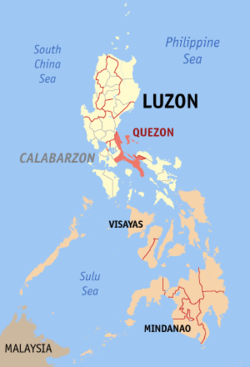Quezon (province)
Quezon (Tagalog pronunciation: [ˈkɛson]) is a province of the Philippines in the Calabarzon region of Luzon island. The province was named after Manuel L. Quezon, the second President of the Philippines, and its capital is Lucena City.
Quezon is southeast of Metro Manila and is bordered by the provinces of Aurora to the north, Bulacan, Rizal, Laguna and Batangas to the west and the provinces of Camarines Norte and Camarines Sur to the east. Part of Quezon lies on an isthmus connecting the Bicol Peninsula to the main part of Luzon. The province also includes the Polillo Islands in the Philippine Sea.
A major tourism draw to the province is Mount Banahaw. The mountain is surrounded by spiritual mysticism with many cults and religious organizations staying on the mountain. Numerous pilgrims visit the mountain especially during Holy Week.
Archaeological excavations in the province attest to its rich precolonial past. Archaeological materials including burial jars, human bones, shell midden and pot shreds have been discovered at different sites in Bondoc Peninsula including the towns of San Narciso, San Andres, Mulanay and Catanauan. The most recent excavations were conducted in Catanauan by the Catanauan Archeological and Heritage Project.
...
Wikipedia




